All eyes are on Burnley, as peculiar as that sounds to say.
The Clarets became synonymous with an unfashionable style and, under Sean Dyche, for defying the odds year after year.
After their luck ran out and they were relegated, it was time for a revolution.
Every adjective previously used to describe Burnley can be abandoned, and as they come back to the Premier League, a completely different club can be expected.
The face of this revolution is the Man City and Premier League legend Vincent Kompany.
The 37-year-old came to Turf Moor with just three years of experience, and as exciting as his potential looked, it was an undeniable gamble.
Similarly, Burnley’s recruitment strategy also suffered significant changes.
Kompany certainly played a hand, with the likes of Josh Cullen and Vitinho coming from Belgian clubs, but the club opted for talented young players who, most importantly, fitted Kompany’s forward-thinking tactical vision.
The rebuilding process began, and for the first time in a long time, the future looked bright for the Clarets.
However, Kompany was just too good.
This tactical analysis will look in-depth at Burnley’s tactics under Vincent Kompany, focusing on whether they can continue to play the same way in the Premier League.
After outlining the context surrounding the English club, this analysis will provide a complete breakdown of Burnley’s tactics in attack, defence, and transitions before looking to answer the big question – can they play the same way and survive?
Ahead of schedule, Burnley are already returning to the Premier League.
The Belgian manager quickly implemented his style of play, and before long, they began to dominate the Championship.
With their fluid Positional Play, the Clarets averaged 64.56% possession and 553.57 passes per 90 last season.
Their dominance in results and performance was undeniable, and their xG and xGA can confirm this.
In the Championship 2022/23, Burnley overperformed their xG of 59.42 with an incredible 72 goals, and their shot map below can help us further understand this performance.
They certainly had their share of long-distance goals, perhaps explaining the discrepancy between the xG and goals.
Regardless, the overwhelming majority of their goals came from optimal locations, in or close to the six-yard box.
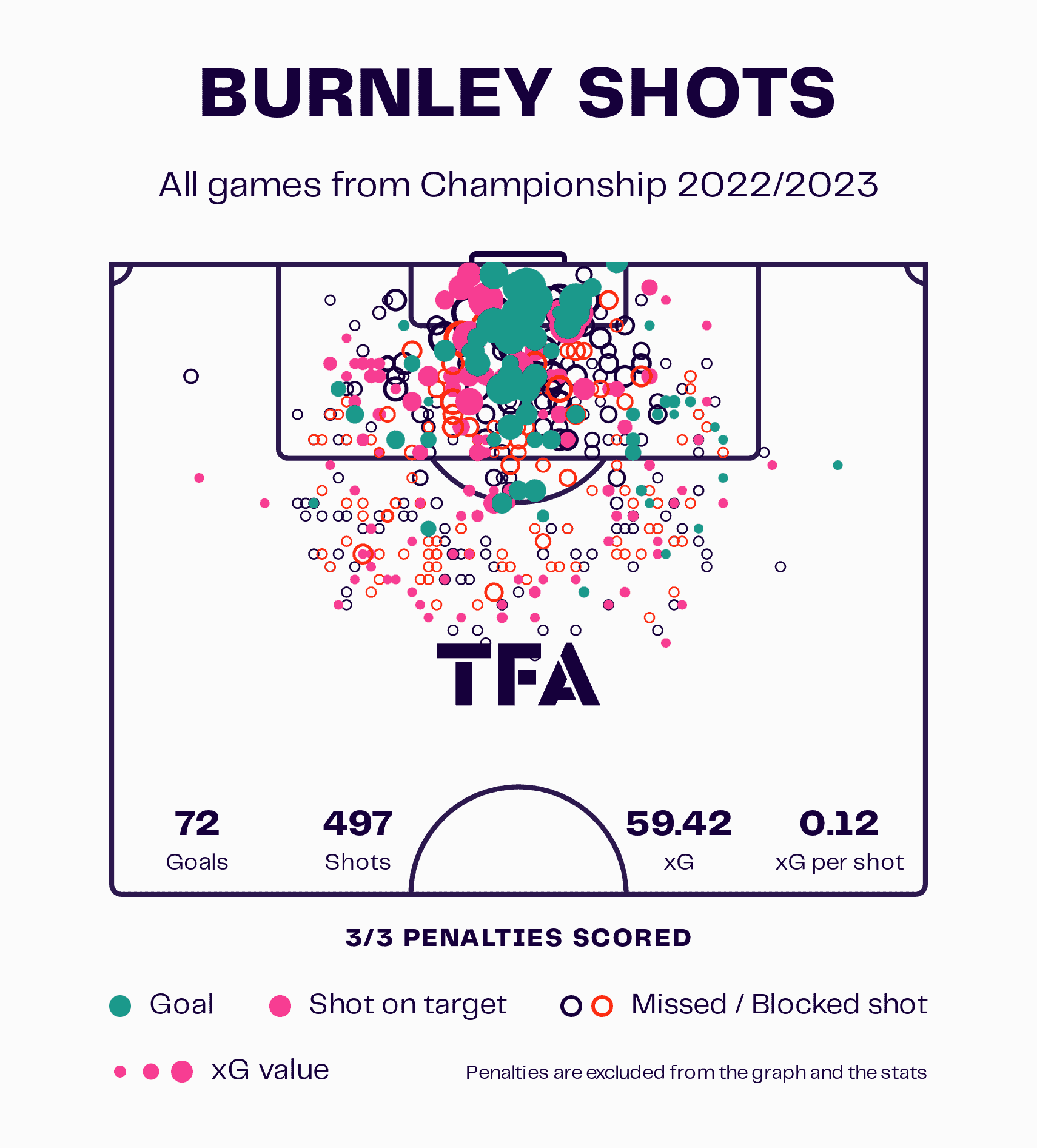
The structure implemented by Kompany allowed for a highly effective attacking system, methodically and intelligently progressing into the final third.
This continued into the chance creation, despite some difficulties in the first stages of the season, which can arguably be attributed to the quality of the players, as Burnley’s squad was, at best, of a similar level to the competition.
Nonetheless, this improved as the season went on with merit to both the manager and his players.
Defensively, they continued to overperform their metrics.
As seen below, their xGA figure amounted to a total of 47.8 while conceding just 35 goals.
Once again, the map helps us illustrate this very clearly.
While they were a few goals conceded from in or close to the six-yard box, the opposition had nearly just as many missed shots from the exact location.
The quality of the chances conceded could be a cause for concern, but the amount is far from it.
Burnley recorded the lowest number of shots against in the league, with just 352 (7.01 per 90) last season.
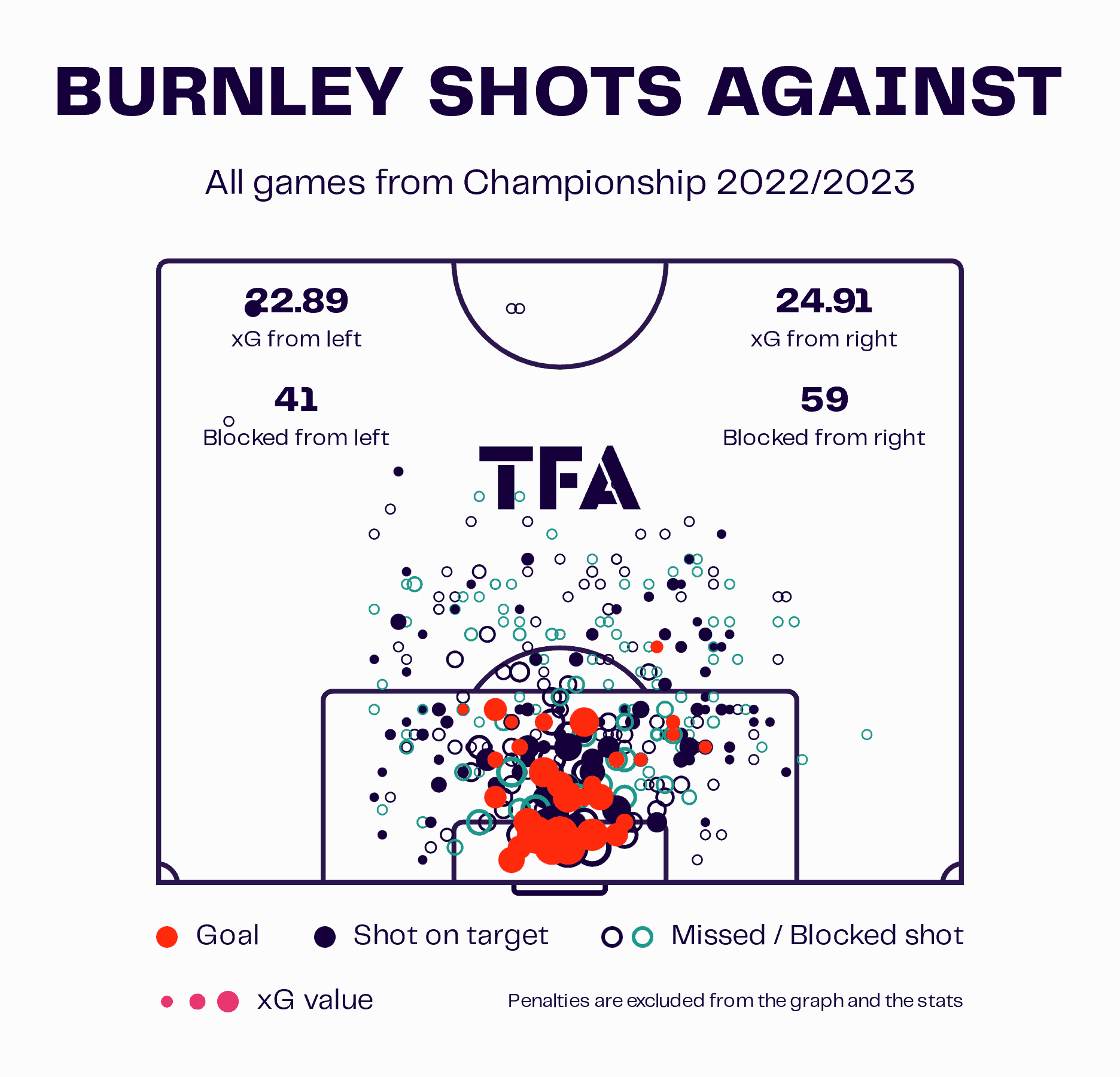
A few narratives can emerge from the data, mostly from their overperformance.
However, considering the revolutionary process the club has gone through and, most importantly, the tactical prowess and dominance they displayed, this overperformance quickly becomes secondary.
Burnley’s performances certainly back up their historic run.
As we look forward to their first year back in the Premier League, it can also provide a clear picture of their tactical context and challenges.
Before diving into the tactical side of things, though, let’s take a look at their recruitment so far, which will prove vital to the development of their tactical ideas in the Prem.
Last season, some of Kompany’s core players were on loan.
Ian Maatsen, from Chelsea, was the preferred left-back.
City’s Taylor Harwood-Bellis was crucial at the back before his long-term injury towards the end of the season.
The dynamic Nathan Tella played a vital role in the side’s attacking creation but has returned to Southampton.
Finally, Borussia Mönchengladbach’s Jordan Beyer was another essential player at the back, especially after Harwood Bellis’ injury.
While Beyer has been permanently signed, the other three are extremely unlikely to return.
Additionally, Ashley Barnes has left on a free transfer to Norwich.
With the departures out of the way, let’s take a look at their squad, including some recent signings.
Euro U21 sensation, James Trafford, has been signed from Man City and will likely compete with Arijanet Murić for the number one spot.
Ameen Al-Dakhil and Jordan Beyer provide youth along with excellent quality at the centre-back position, with Dara O’Shea and Hjalmar Ekdal as backups.
Connor Roberts is a no-brainer on the right, Charlie Taylor will probably replace Maatsen on the left, and Vitinho can fill in for either side.
Continuity will be critical in the defence, as Kompany has retained most of his options.
The quality and youth are undeniable, but reliable depth could be an issue.
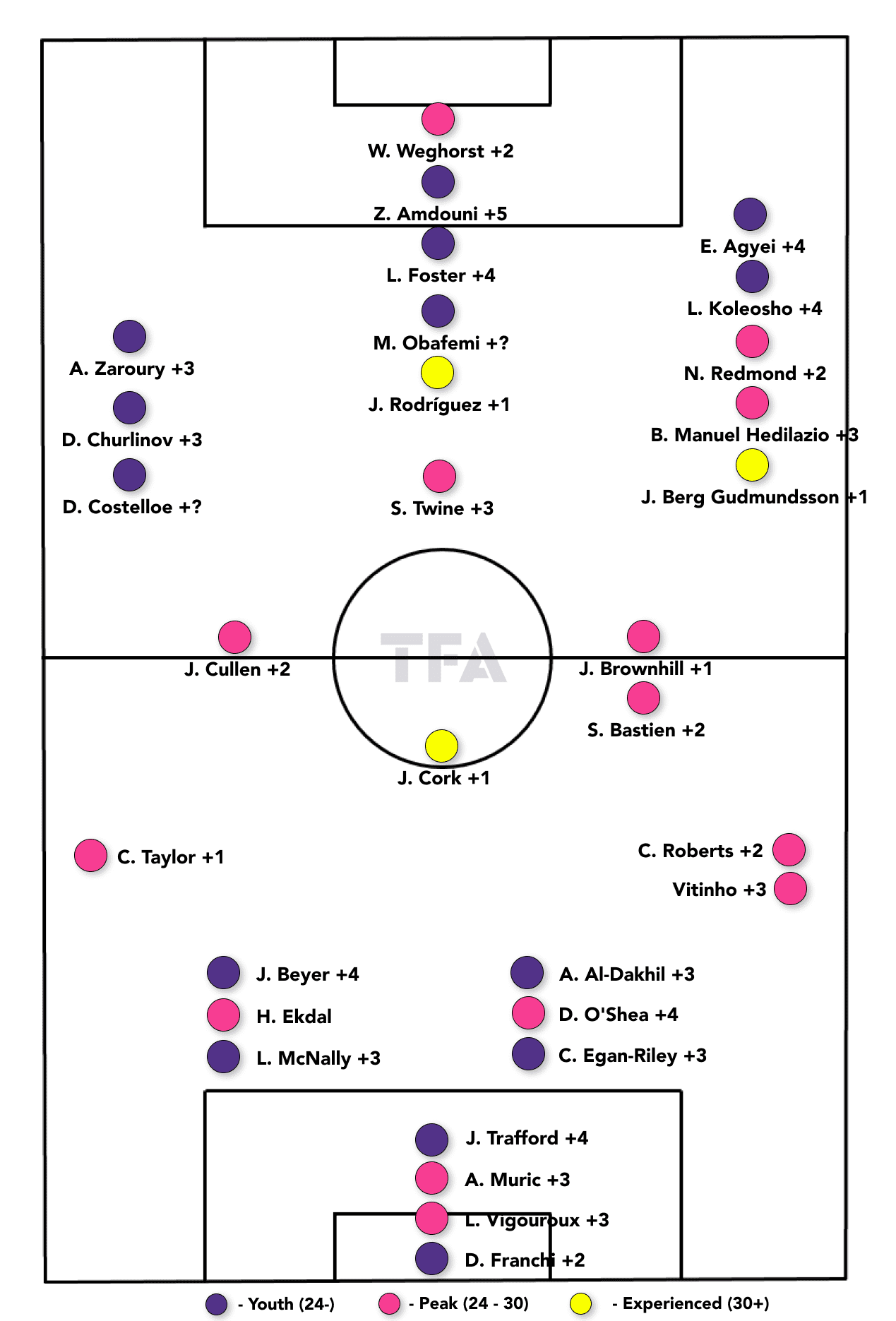
The midfield continues strong, with the key players still at Kompany’s disposal.
Similarly, the attack has not suffered many changes.
The signing of Nathan Redmond, an improvement with the same profile, immediately replaced Ashley Barnes’ departure.
Zeki Amdouni is an exciting signing from Switzerland, and he will be looking to fill the hole left by Tella.
Additionally, Jacob Bruun Larsen and 18-year-old Luca Koleosho have been recently signed to strengthen the attacking depth.
There is a question mark around Wout Weghorst, who, while involved in the preseason, has an uncertain future at the club.
Otherwise, the Clarets continue with similar personnel.
Their transfer strategy has been clear.
Unlike Nottingham Forest last year, who completely transformed their squad after promotion, Burnley have gone for continuity and surgical signings, primarily addressing the holes left by the loan departures.
Arguably, taking few risks in the transfer market is a risk in itself.
On the other hand, trusting the process and giving Kompany continuity could prove key in a problematic season back.
Finally, while Burnley are linked with a few more names, we would like to suggest the 21-year-old left-back from Feyenoord, Quilindschy Hartman.
Hartman’s young and high-potential profile fits the club’s new vision, and according to our xGOLD tool, he is an 83% match with the club.
The Eredivisie-winning fullback displayed great potential last season, and his statistical overview below agrees.
Particularly in possession, Hartman could replace Maatsen’s role and be an essential piece in Kompany’s puzzle.
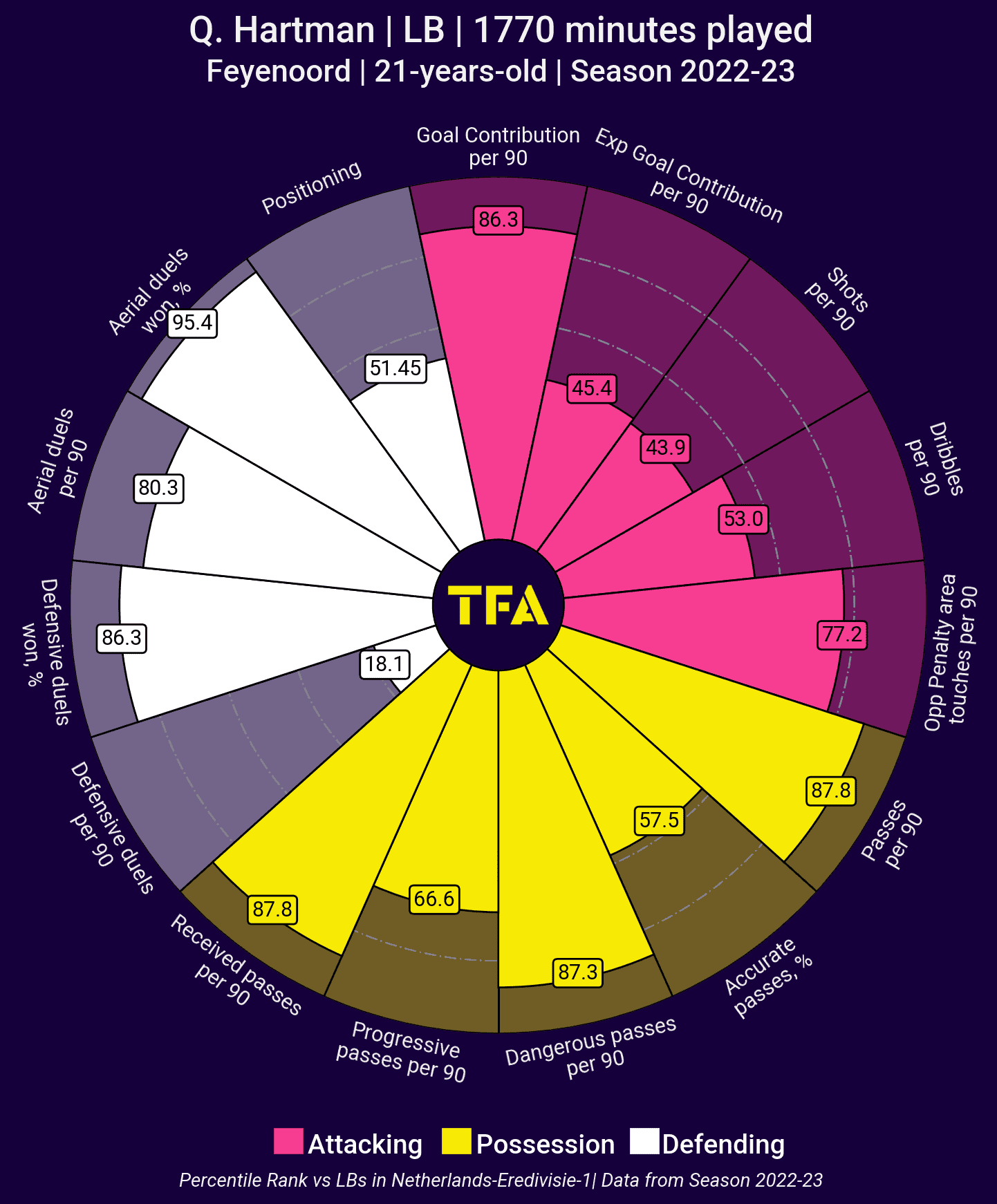
Attacking phase
Ahead of their first season back, Burnley have opted for continuity, and with such, our tactical preview of the Clarets becomes much more straightforward.
With the setting all laid out, let’s dive into Vincent Kompany’s tactical system.
Averaging 65% possession, they spent the majority of the year in the attacking phase, and this can be attributed to a few factors.
First, Kompany’s ideal undoubtedly revolves around dominating possession and using it as a tool to control the game and efficiently develop their attacks.
Of course, there will be a collective mentality to retain possession.
Additionally, with Kompany’s intelligent tactical manoeuvres, Burnley were able to outplay their opponents consistently.
This is a broad statement, but it leads us into the attacking system, first with the build-up.
In the first phase, the Clarets looked to construct possession with control.
The tactical context of the league played a crucial role in this.
In the Championship, teams rarely looked to engage in complex tactical battles in this phase — at least creatively, pressing was not common.
Consequently, they were able to reach the middle third with complete control of possession consistently and, most importantly, the space.
Before we look at their work in the middle third, let’s explore how their build-up was so successful.
Despite their 4-2-3-1 on paper, Kompany’s men rarely looked to build up with a 4-2.
Instead, there were multiple variations, and this is where the Belgian manager proved to be extremely adaptable.
The side’s structure was constantly able to adapt to the style of the players, while always respecting the rules of Positional Play.
These variations depended on the players, of course, but also the opponent.
Even within the same match, Burnley could adapt and deploy numerous solutions.
More often than not, they looked to form a back three in various ways.
Asymmetrical fullbacks were the most common, but one of the central midfielders could also drop alongside the centre-backs.
In the example below, Burnley played out to the right after Sheffield United’s strikers closed in on the left side.
Josh Cullen dropped in line with the centre-back, dragging Sheffield’s Tommy Doyle with him.
This cleared the passing lane for Tella, who received the ball with space to turn and advance into the middle third.
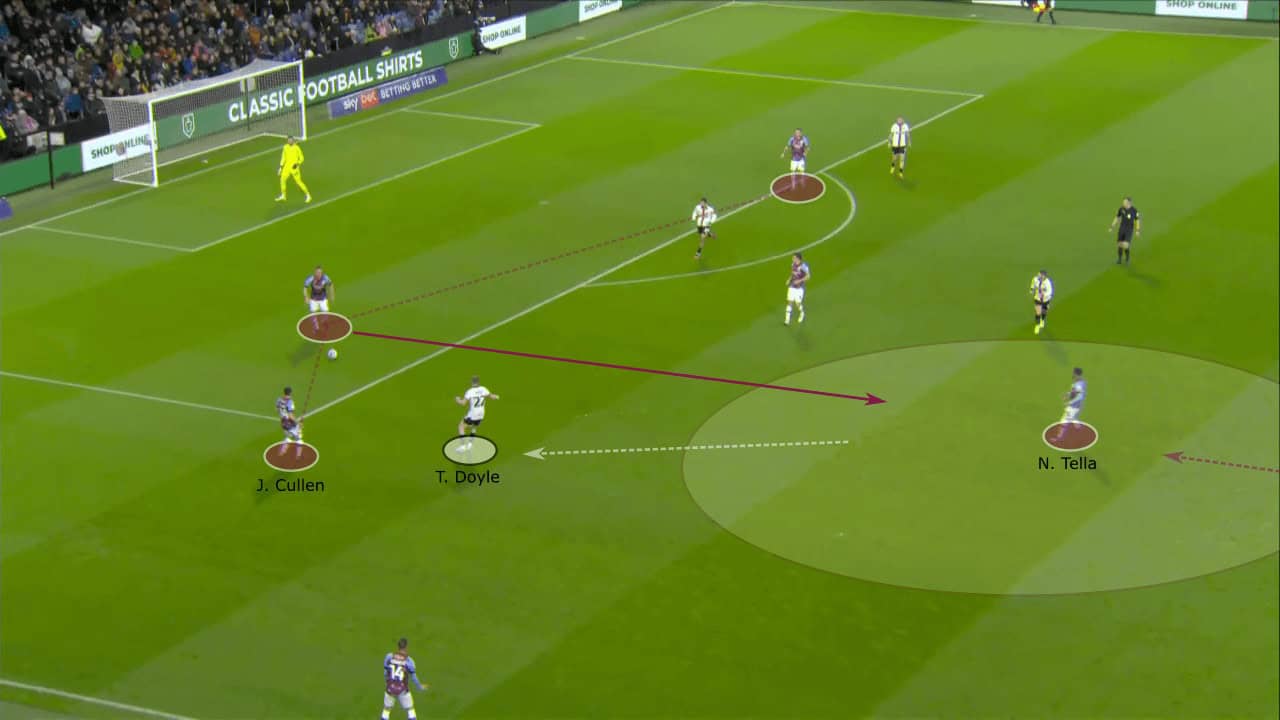
In another scenario, the right-back Connor Roberts inverts all the way to the left side behind the first line of pressure, creating a 2v1 against Cardiff’s midfielder.
From the defender’s confusion, they create minimal space to receive, turn, and play it out in the middle third.
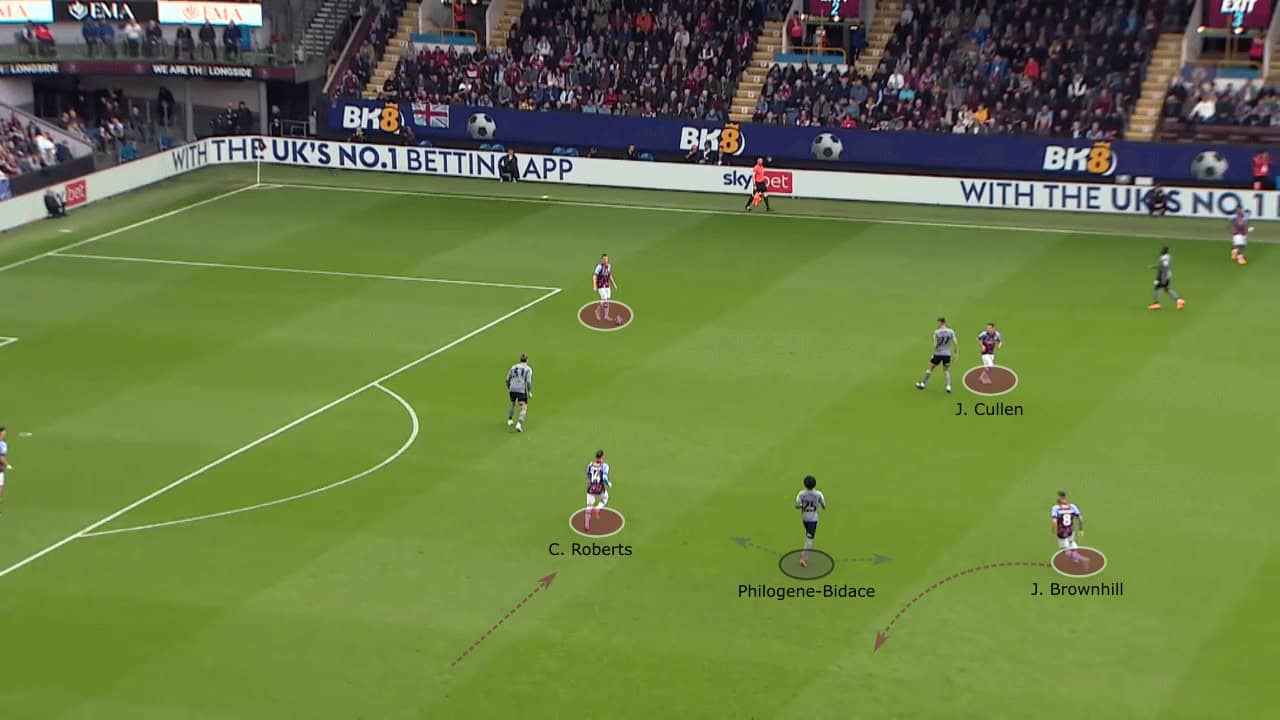
In both scenarios, the structures are very different.
Whether it is a 3-2, 3-1, 4-1, or even a 4-2, Burnley’s structures in possession are constantly changing and, frankly, unimportant.
Principles instead of shapes guide Kompany’s men.
These range from providing diagonal angles to the ball carrier to the decoy runs made to manipulate space.
Their possession then becomes much more fluid and dynamic while always maintaining great organisation.
It can be the central midfielder dropping between the centre-backs or wide as a “full-back”.
It can also be the right-back coming inside while the left-back tucks in as a third centre-back, or maybe the left-back pushing up while the right-back tucks in.
With such structural variety, Burnley have been constantly able to outplay their opponents and gain control of the game.
This continues into the middle third, where they assert themselves and look to progress into the final third.
The structures continue to be everchanging while always guided by principles, where they are not only able to control possession but the pitch as well.
As illustrated below, players are very rationally spread throughout the pitch.
As they assert control, they then look to begin searching for solutions.
The ball is circulated around the back, and there are always plenty of options for the ball carrier.
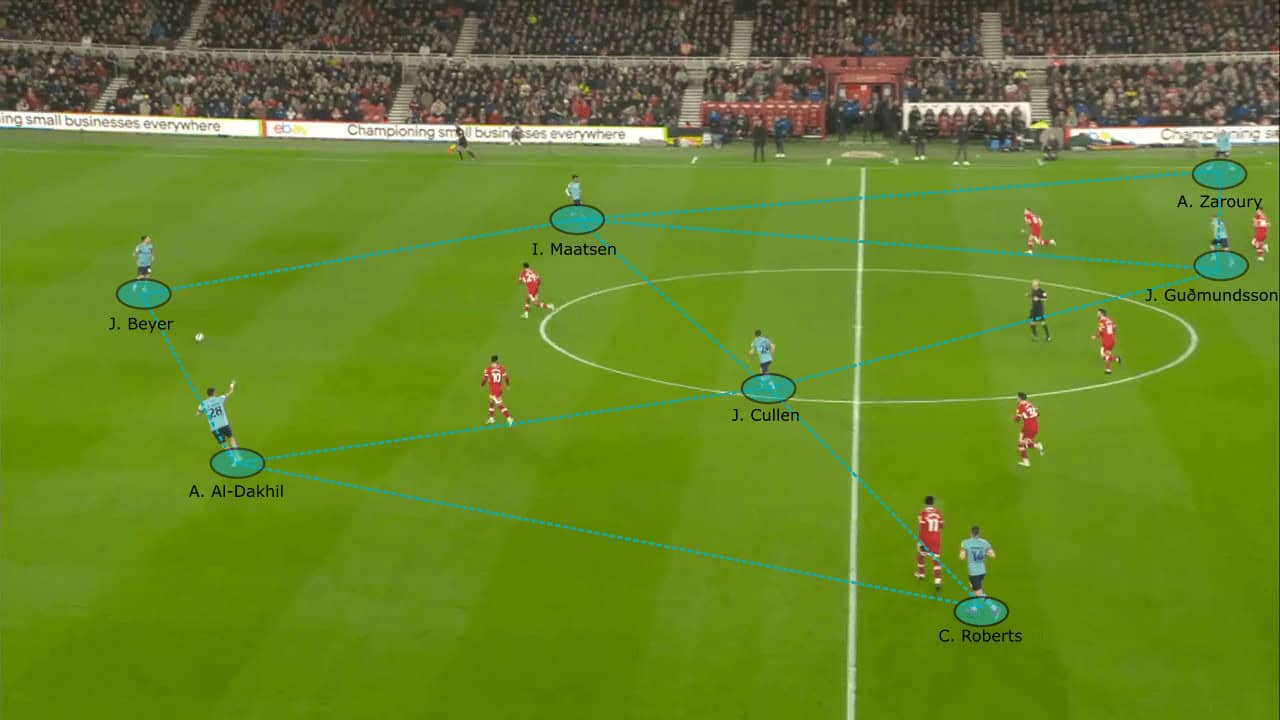
In the image below, we can observe a few principles in action and better understand how they progress.
In this scenario, they are in a 3-1 shape.
Both fullbacks remain wide while one of the central midfielders drops on the right side of the centre-backs to form a back three.
The other CM, Jack Cork, sits ahead of the back three.
The fullbacks’ wide positioning allows for the more advanced players to come inside, as illustrated on the left.
Josh Brownhill, who plays a more advanced role in this match, makes a forward run attacking the depth.
Meanwhile, Lyle Foster, the left-winger, drops inside.
These sorts of rotations and movements are constantly used to disrupt the defensive organisation, ultimately waiting for the opposition to make an error.
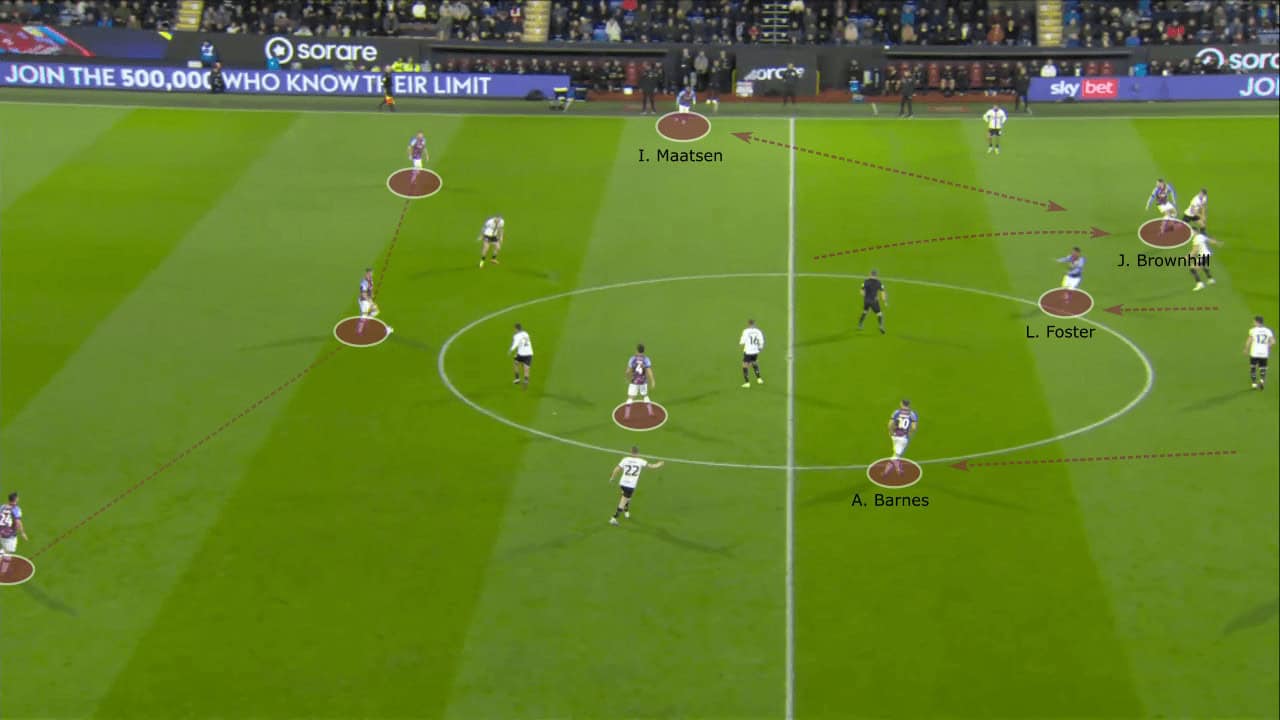
Throughout the entire season, against varying oppositions, they were consistently able to assert control of the game and methodically search for progression into the final third.
While there was fantastic organisation, which is so crucial for their control, there was also great flexibility.
Kompany has been able to constantly adapt his structure to the players and to the opposition.
After a while, the players have become able to deploy various structures within the same game.
Defensive phase
If the revolution wasn’t clear enough already, Burnley did not do much defending in the Championship.
Being able to hit the 70s in the possession figure constantly, there were matches where they simply were not tested defensively.
However, their high press was always key in ensuring this dominance.
The Clarets averaged the league’s lowest PPDA and highest challenge intensity.
Their high press began with a relatively passive approach.
Their 4-2-3-1 turned into a 4-3-3 or a 4-4-2, depending on the opposition.
In these two shapes, the first line of pressure was moderate.
On the contrary, they looked to eliminate access to the central areas before advancing to the centre-backs.
This was done in various ways, depending on the opposition’s shape.
In the instance below, Barnes pressures the goalkeeper while Jóhann Guðmundsson sits on the centre-back.
After the ball is played wide to the right-back, Guðmundsson jumps to apply pressure while Barnes tucks inside to pick up the centre-back.
This rotational nature between the front line is ubiquitous, looking to dismiss the opposition’s numerical superiority and force them into unfavourable situations.
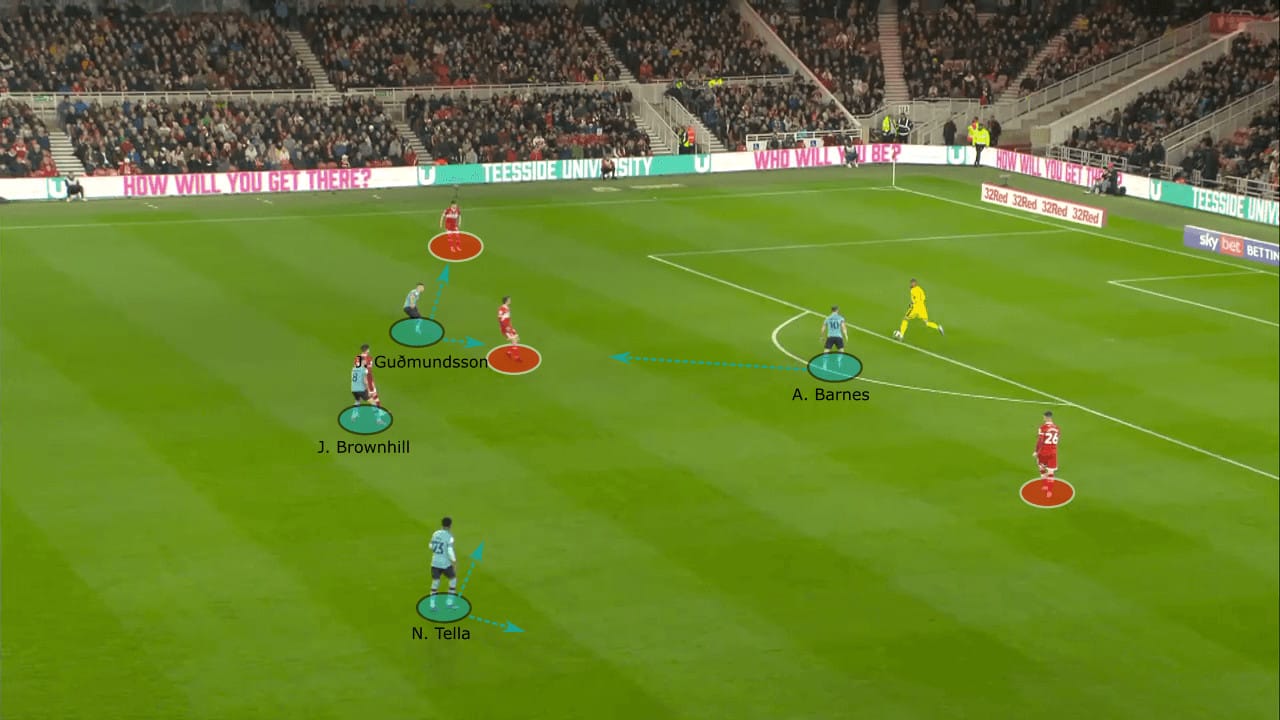
In other instances, the first line may look to completely sit off the centre-backs until the ball is played wide.
With the wingers starting on the half-spaces and the centre-forward blocking access into the midfielders, they force the opposition to play into the fullbacks.
In the instance below, after Sheffield play wide, Tella shifts to apply pressure while Cullen comes to pick up the near midfielder.
After the fullback receives it, Barnes finally jumps to the centre-backs to keep the opponent trapped wide.
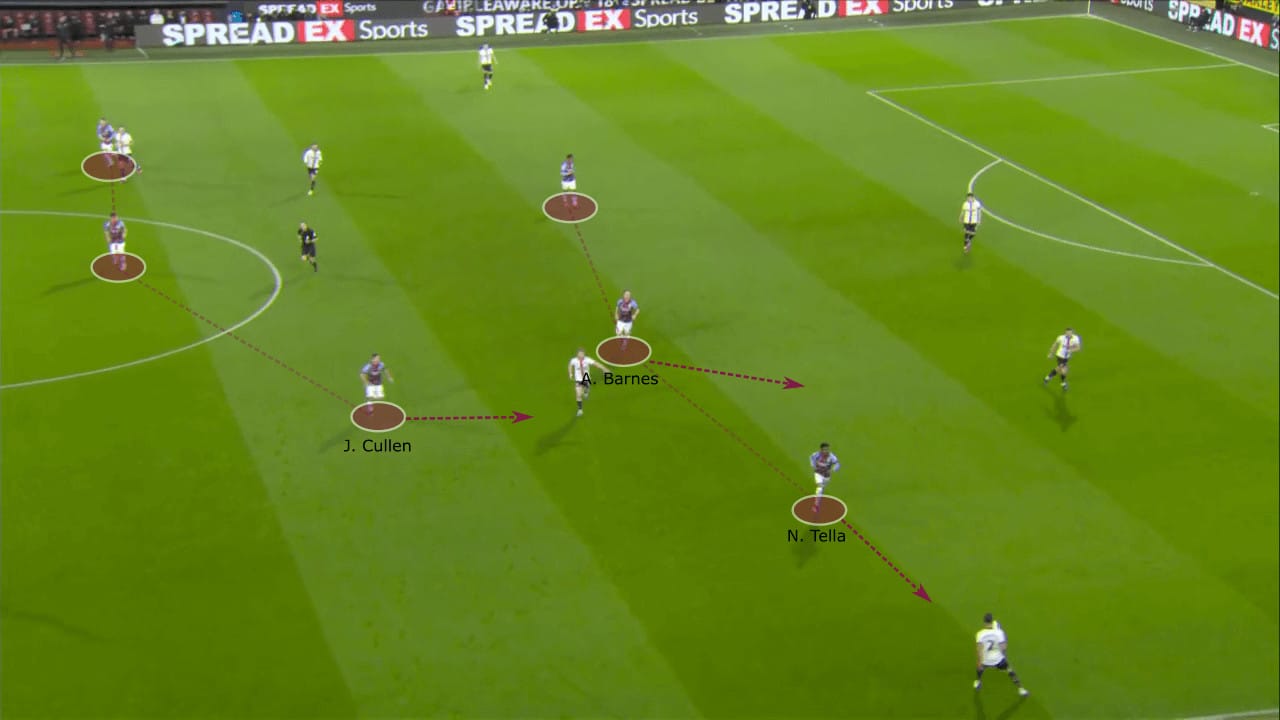
Settling into a mid-block, they deploy a similar structure.
The wide players begin on the half-spaces, compacting the structure laterally.
The first line of pressure also sits deeper, blocking access to the central areas.
If the ball is played centrally, Burnley can easily overwhelm the receiver and regain possession.
The objective, once again, is to force the opposition to either go wide or over the top.
In either case, the play becomes more direct, and the opponent has less control over the outcome.
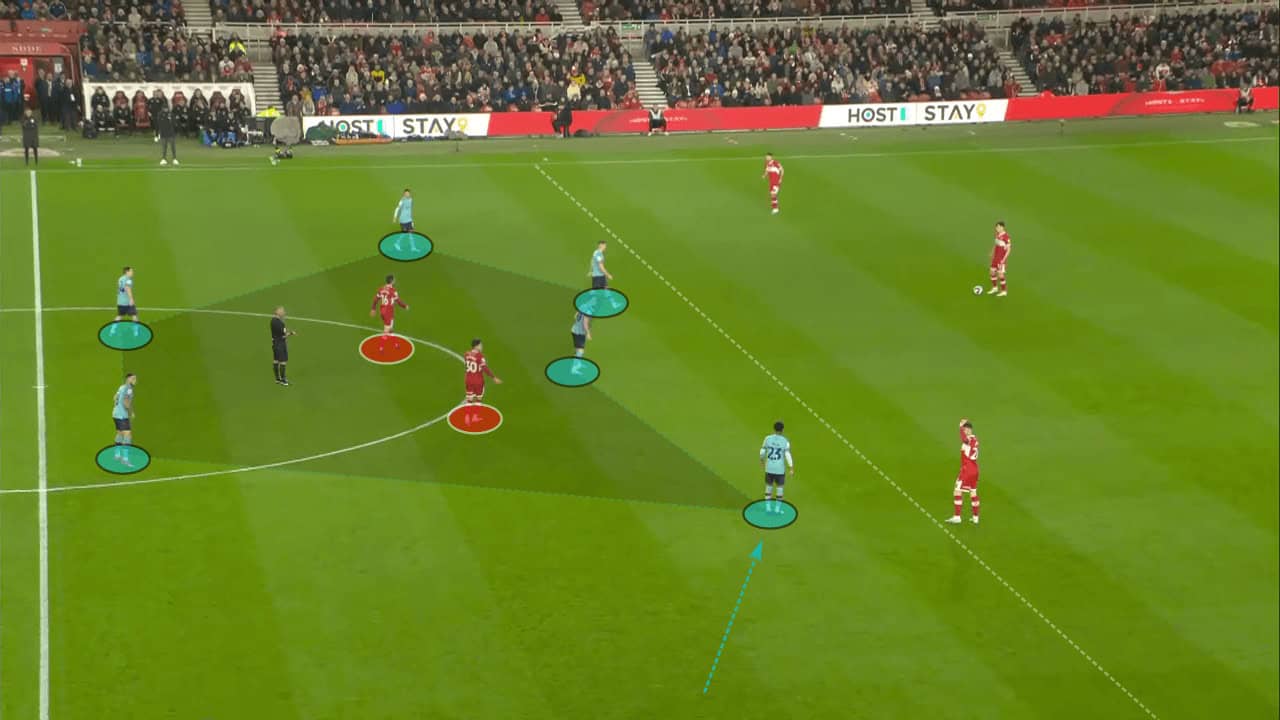
Transitions
Burnley’s transitions function to complement their work in and out of possession – it is impossible to look at the former without considering the latter.
Let’s start with the defensive transitions by looking at their rest defence in possession.
As they progress into the final third, Burnley will look to maintain either a 3-2 or a 2-3 structure at the back.
Below, against Cardiff, it is a 2-3 with the fullbacks tucking inside.
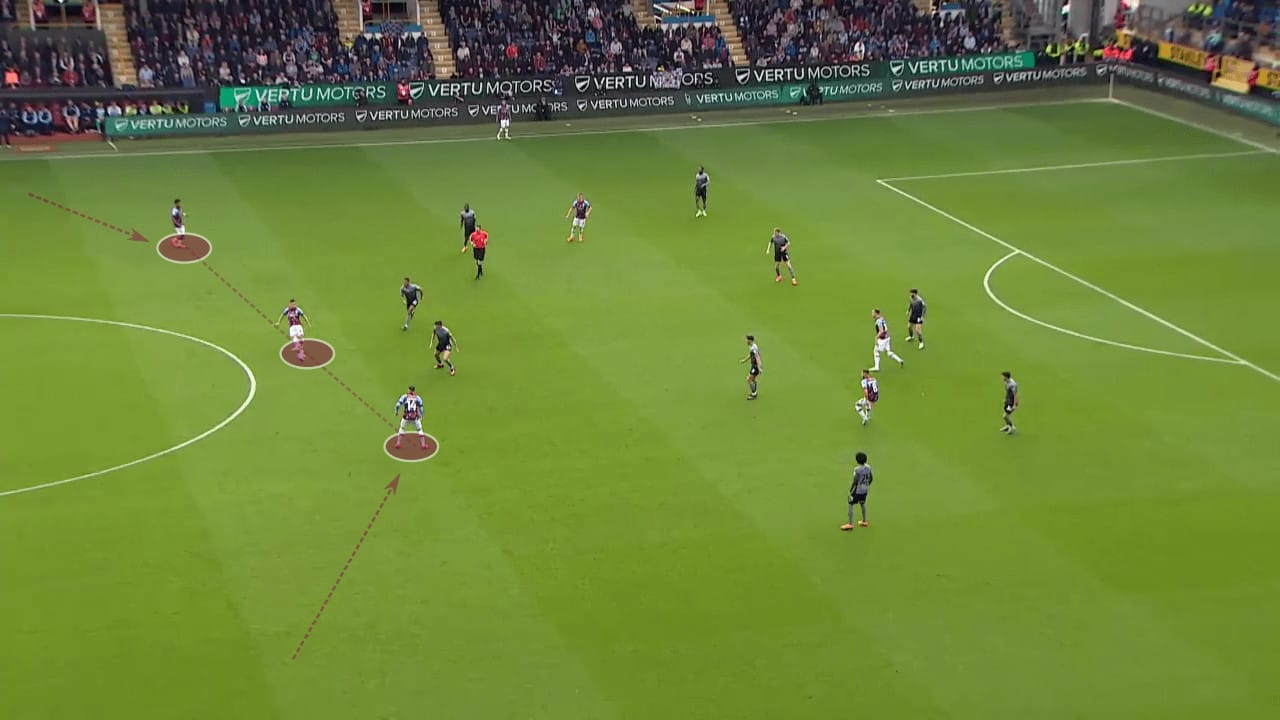
In either shape, the objective is to effectively counter-press the opposition in case the ball is lost.
The two shapes allow immediate protection of the central lanes, the most dangerous area in a counterattack.
Additionally, with an initial five players, they will always outnumber the opposition in that area, being able to pick up options while also providing cover.
In the instance below, once Cardiff recovers the ball, the Clarets launch their counter-pressing system looking to kill the transition.
All three immediate options are closed off, and the ball carrier is forced to go long, where Burnley have a 2v1 against the centre-forward.
This system is vital in allowing them to suffocate the opposition in their half and keep them from getting out.
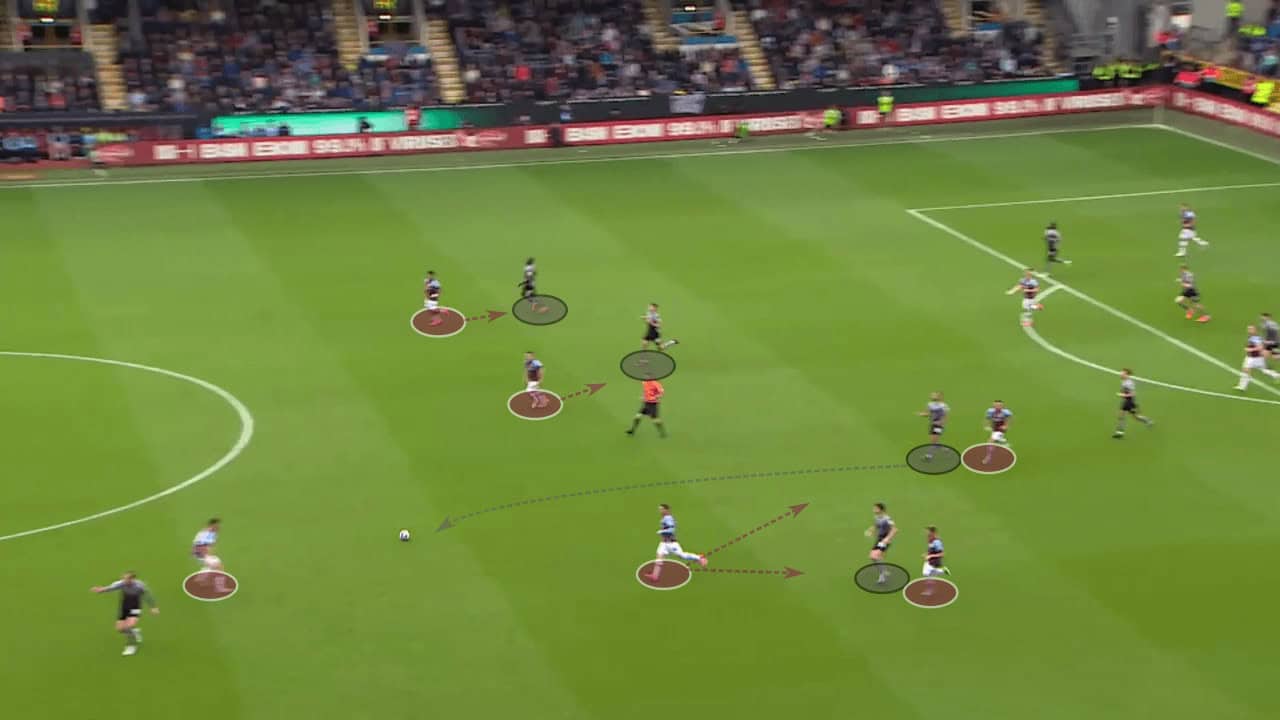
Similarly, their attacking transitions work hand-in-hand with their pressing system.
In deeper areas, unless there is a significant number of opposition players behind the ball and space to progress, they will look to retain possession and assert control.
In higher areas, however, they will often look to transition into an attack immediately.
In such scenarios, not only is the ball already in a dangerous area, but there is also a relatively low number of defenders in front of the ball.
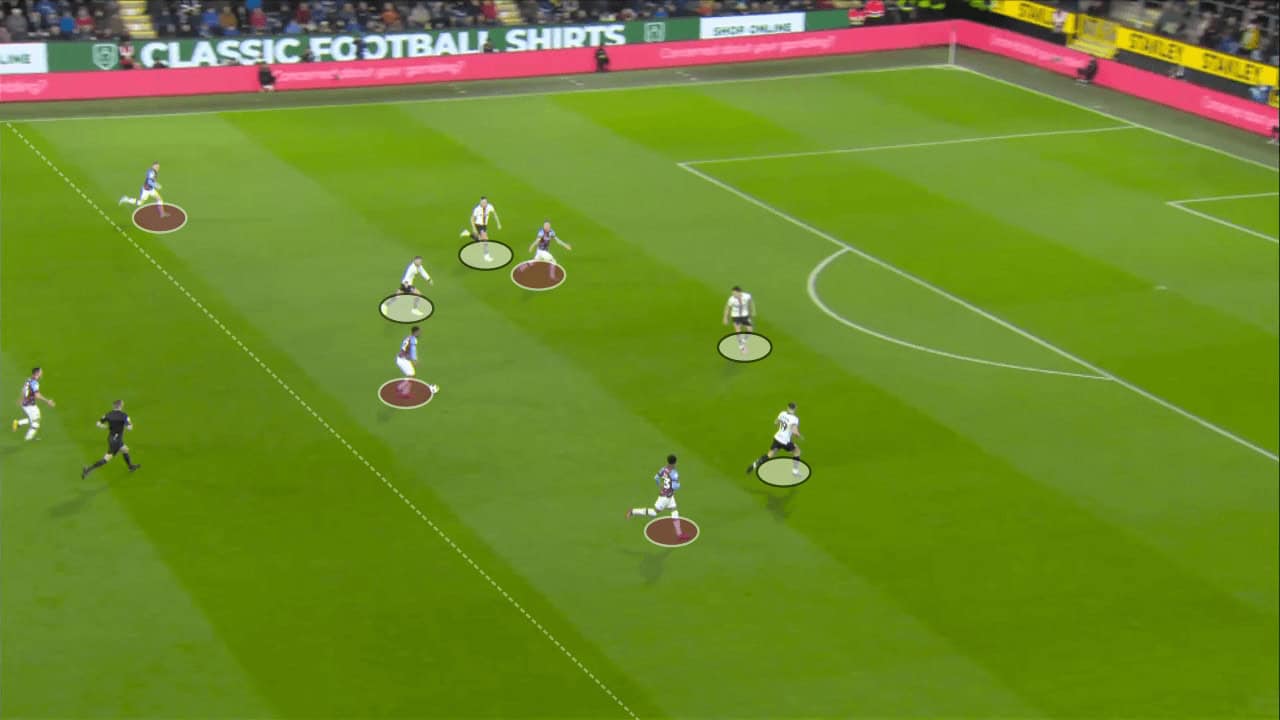
Can they survive?
Now to the big question – can Burnley continue to play the same way and survive? Hopefully, after this analysis, we can attack this question with more clarity.
There are many layers to it, but they simply will not be able to continue to play the same way.
Below, we can see their statistical overview for last season.
Their dominance is not even questioned; they rank incredibly high in all categories.
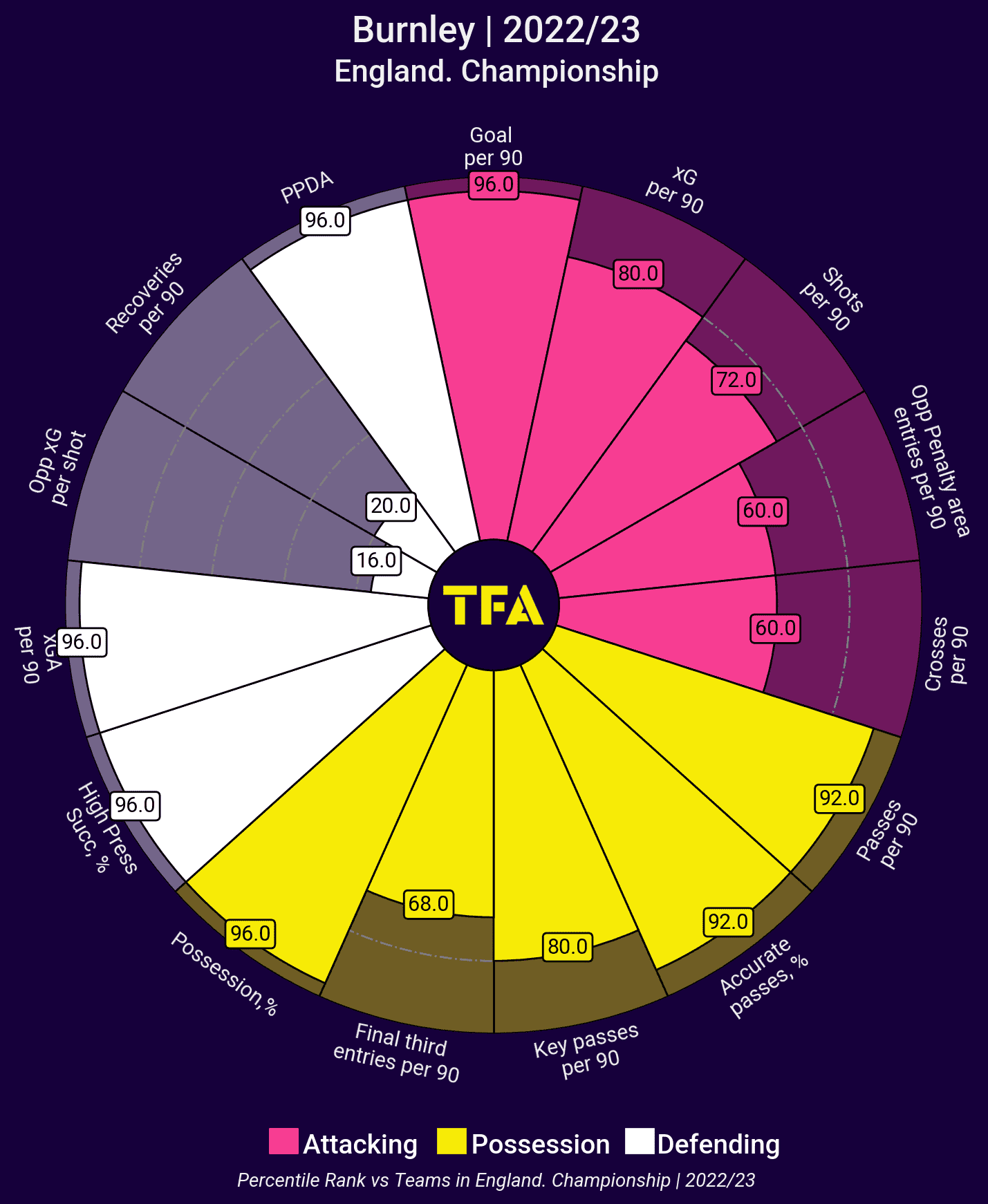
This dominance will obviously not hold up in the Premier League, and many of these metrics will begin to fall.
However, this is the easy answer, and there is a more complex road.
Let’s start with the build-up.
As mentioned, in the Championship, the complexity of build-up scenarios was not very high and nowhere near the level of the Premier League.
The variety and quality of pressing scenarios will significantly increase, which will be the key factor.
If Kompany and his men can relatively succeed, they will enjoy greater control and more attacking volume.
However, they will be forced into a completely different attacking approach if this proves too difficult.
If they can really succeed and force teams into lower blocks, their ability to create chances in the final third, particularly against deep blocks, will be questioned.
Ultimately, the Premier League will pose a far more complex challenge to Kompany’s attacking system.
Their success, from third to third, may answer the question, and it certainly could be a yes.
However, the overwhelming dominance they enjoyed in the Championship is entirely unrealistic.
Out of possession, Burnley’s system should prove a formidable challenge to many clubs in the Prem.
Undoubtedly, their aggressive nature will be able to continue, and if consistent, it could play a significant role in their survival.
Rather than being pushed deep for long periods, as many newcomers are, they should be able to fight back with an aggressive game.
So, the question focuses entirely on their attacking system, specifically on the build-up.
Their success in the first phases of possession will ultimately determine what sort of team they will be, and the fact that this area was not overly tested in the Championship makes this very interesting.
Key player
Just as the build-up will be crucial to their survival, Josh Cullen will play a key role in the Clarets’ fate.
The Irish midfielder came from Anderlecht as Kompany’s trusted man, and in the Championship, he was undoubtedly indispensable to Kompany’s success.
His versatility is important in their flexible approach, essentially allowing for such adaptability in possession.
Not only can Cullen perform multiple roles in possession, but he can also identify when to perform such roles.
In harmony with Kompany’s principles, he was a tactical reference in the side’s structure, knowing when to trigger certain movements and structures.
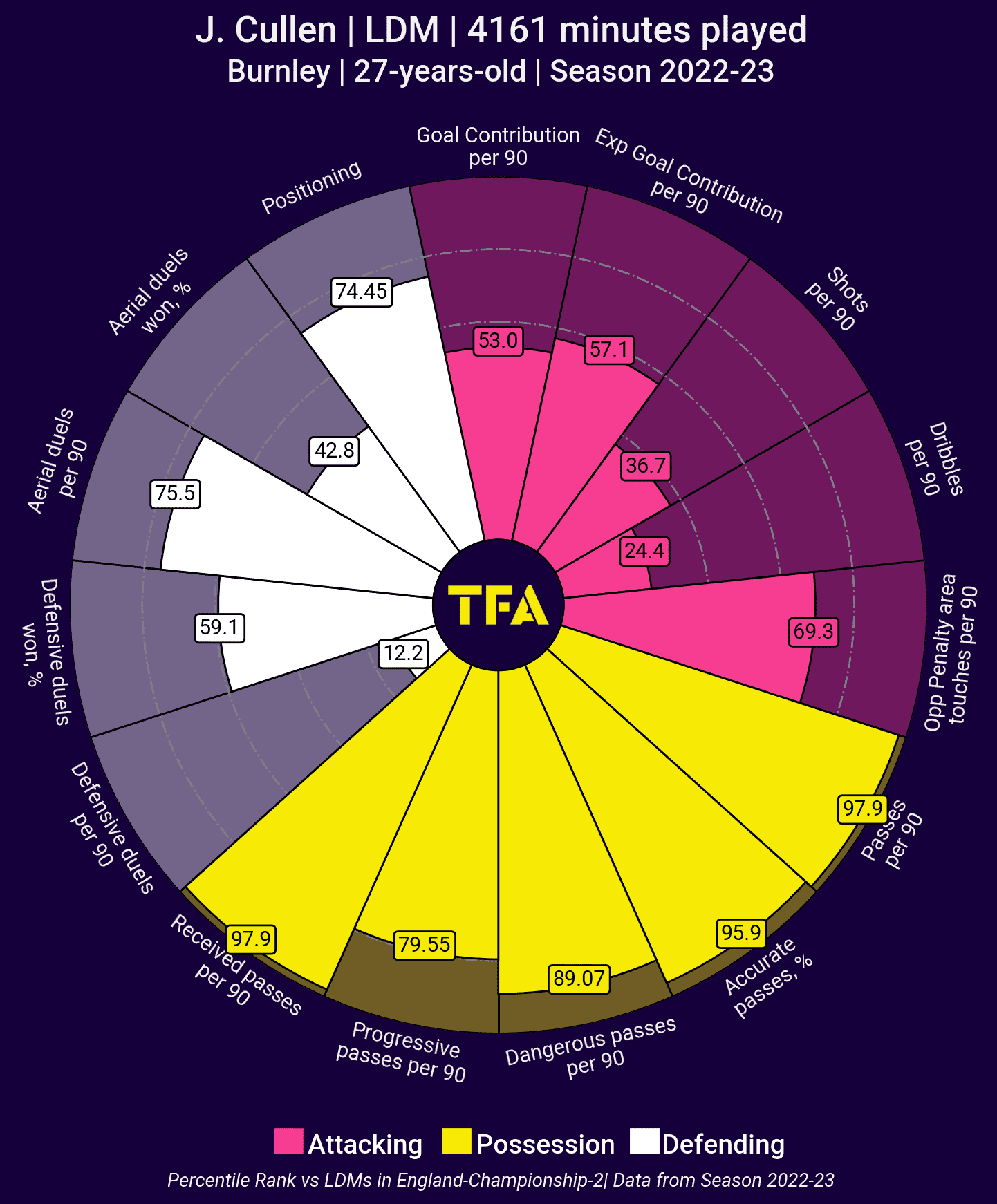
The statistical ranks above further illustrate his importance, particularly in possession.
The 27-year-old was at the top in nearly all metrics, highlighting his importance to the functionality of Kompany’s system.
One to watch
The 22-year-old Zeki Amdouni will be one of the players to watch in this Burnley side.
The Swiss attacker joins from Basel, and his statistical profile immediately makes him an extremely exciting prospect.
His positioning percentile is high, and he also ranks extremely high in all possession metrics.
Despite being a forward, he will play a very important role in Burnley’s progression into the final third.
Similarly, he ranks high for dribbles per 90 and expected goals contribution.
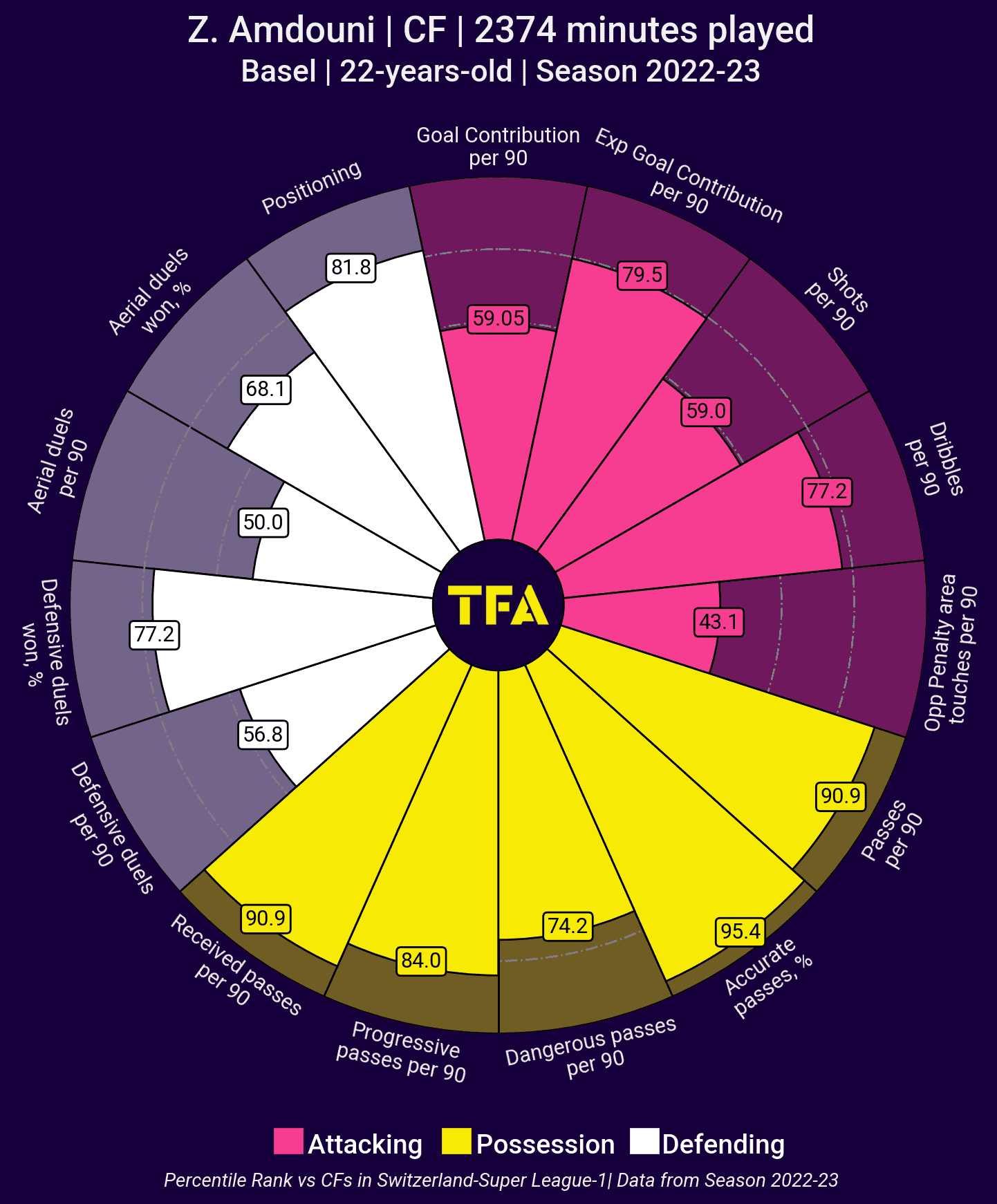
While the Swiss attacker comes into the Premier League relatively unknown, it would not be a surprise to see him become one of the breakout stars of the season.
With Nathan Tella’s return looking highly unlikely, the former Basel player could play a vital role in Kompany’s attack.
TFA Verdict: 14th
Can Burnley come up, play that style of football and not go straight back down? In a word, yes.
The club continues to recruit very well into their game plan and in Kompany they clearly have a manager who will relish being back at the top table of football.
A strong start could fade and the team ends up 14th as opposed to clawing their way out of a relegation battle.





Comments